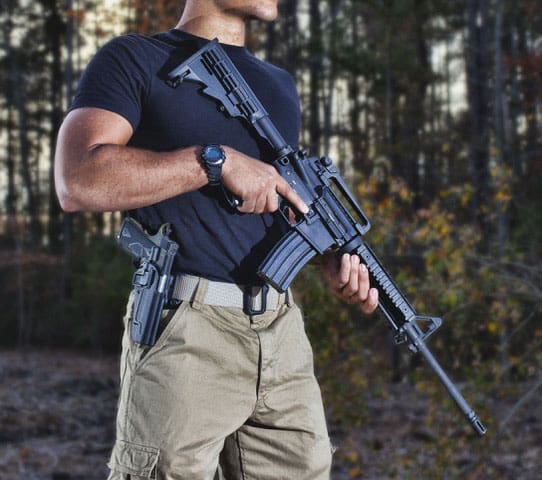[HTML1]
“We’ve all seen dash-cam videos of officers standing in the open and repeatedly yelling commands to ‘Drop the gun!’ at noncompliant, threatening offenders. The officers are not using the deadly force that they’re legally justified in using, and they’re not doing anything else–like moving to cover or withdrawing–to gain a tactical advantage. These officers get caught in a repetitive verbal loop because they perceive they are losing control of the situation and they can’t figure a way out. They are tactically frozen.” The warning comes to us from the Force Science Institute executive director Dr. Bill Lewinski, and it applies to civilians as well. The first part (warn) and the second (act) . . .
Many armed self-defenders reckon it’s all about speed. Fast threat assessment. Fast un-holstering. Fast shooting. While you may face a situation where speed and speed alone equals survival, you’re just as likely to get caught-up in a [relatively] slow-building self-defense scenario. In that case, there’s work to be done.
[Note: life is chaotic. This is merely a guideline based on information gleaned from personal practice and gracious gun gurus: the rabbi, AFS and others. YMMV.]
Step one: evade
If you detect a threat early enough, take effective evasive action. For example, if you see a bad guy in a parking lot, put a car between yourself and and the potential perp. If a pack of predators are walking towards you, cross the street.
Step two: escape
If you can run away from a threat, do so. If you’ve got small children or other less mobile dependents, calculate the chances of a successful escape. Sometimes you have to make a stand.
Step three: brandish
You have VERY little time/distance to draw your gun. If you’re going to do it, do it. If you wait too long, the window of opportunity will slam shut.
That said, you have more time than you think. When adrenalin flows, your reactions quicken. In effect, time slows down. Draw your weapon slowly and carefully. As you do so, MOVE.
You may move away from the threat, towards cover or concealment. You may move towards the threat, ensuring accuracy and capitalizing on the element of surprise. But don’t just stand there like an English pointer. That dog won’t hunt.
Step three: warn
Yes, another step 3. If you have time, issue a verbal warning as you un-holster your weapon and move to cover/concealment, or towards the threat.
First, it might work. Wouldn’t it be nice if you shouted “Back off!” or “Drop your weapon!” and the perp did as instructed? By the same token, it would also be helpful if every perp had a weapon in their hand. Or not.
Anyway, who wants to shoot someone? The paperwork is diabolical. The cost (in terms of time and money) is astronomical. The hassle is unfathomable. A verbal warning that works is worth your weight in Hornady Critical Defense rounds.
Second, a verbal warning creates an excellent legal defense. A witness who hears you warning the perp can provide compelling evidence that you only shot because you had no choice. The folks at Armed Response suggest “Don’t make me shoot you!” Magic.
Third, a verbal warning is a kind of moral tripwire. Hey, I warned the guy. Now I can let loose the dogs of war.
Step four: shoot
Dr. Lewinski is spot-on: hesitation kills. If you’re going to move, move. If you’re going to shoot, shoot. Center mass. Double taps. Whilst moving. But whatever you do, DO SOMETHING.
Remember that the bad guy or guys may be high on drugs, mentally ill or so pumped-up and focused on your body language that they can’t process the simplest command. That’s their problem, not yours. Also, you’re not a cop; arresting the bad guy (i.e. holding him or her at gunpoint) is not a viable option.
Step Five: stay alert, call the cops, tell witnesses to stay put
If you shoot, make sure the threat has stopped and there are no more threats nearby. Call the cops. (We’ve discussed the protocol before.) Then issue another verbal instruction. “Stay here. The police are on their way.” You want witnesses. Witnesses want to leave. Luckily, their instincts tell them to obey the guy with (or who had) the gun.
Again, this is a process. It won’t apply to every situation. It could easily disappear in the fog of war. But the crucial point: have a plan and keep moving forwards. Above all, practice. As Dr. L says . . .
You can’t think creatively at the moment you’re confronted with the possibility of your own death, especially if you’ve never been in a similar situation before. Your preparation must come before the event. And that means experiencing an abundance of realistic, force-on-force scenarios, performed at gunfight speed, even if this training has to be done on your personal time. This will embed options you can call forth when you need them so you don’t just keep yelling at an offender who isn’t listening.




“If you shoot, make sure the threat has stopped and there are no more threats nearby. Call the cops. (We’ve discussed the protocol before.) Then issue another verbal instruction. “Stay here. The police are on their way.”
I see how that makes sense, honestly I do. But ordering a stranger not to leave the scene while you have a gun in your hand sounds awfully close to the legal definition of kidnapping or unlawful imprisonment. Any lawyers in the AI have an opinion here?
I think “intent” would mean something. However, depending on the jurisdiction, just performing the act is all the “intent” that’s needed. (Even if you didn’t have the intent to intend to commit a crime/civil tort.)
I suck. Back to civil litigation.
I’m an attorney … but I do not practice in criminal law, so I won’t claim to be an expert on this topic. Having said that, I think I have this one covered: Kidnapping typically requires an intent to deprive someone of their liberty, a lack of legal authority, and some sort of transportation (however slight) or secret confinement. So long as you don’t move or conceal them, you have not violated the third prong. Also, if you have personally witnessed the commission of a felony, you have legal authority in most (if not all – be sure to check your jurisdiction’s laws) to detain the perpetrator until LEOs arrive on the scene. I probably would not do it unless the crime I witnessed was a very serious felony (murder, attempted murder, rape, etc). In most cases, you will end up having to hire an attorney to deal with the aftermath of the situation.
Here are the relevant excerpts from Oregon’s criminal statute (my home state):
ORS 163.225 Kidnapping in the second degree
(1) A person commits the crime of kidnapping in the second degree if, with intent to interfere substantially with another’s personal liberty, and without consent or legal authority, the person:
(a) Takes the person from one place to another; or
(b) Secretly confines the person in a place where the person is not likely to be found.
(2) It is a defense to a prosecution under subsection (1) of this section if:
(a) The person taken or confined is under 16 years of age;
(b) The defendant is a relative of that person; and
(c) The sole purpose of the person is to assume control of that person.
ORS 163.235 Kidnapping in the first degree
(1) A person commits the crime of kidnapping in the first degree if the person violates ORS 163.225 (Kidnapping in the second degree) with any of the following purposes:
(a) To compel any person to pay or deliver money or property as ransom;
(b) To hold the victim as a shield or hostage;
(c) To cause physical injury to the victim;
(d) To terrorize the victim or another person; or
(e) To further the commission or attempted commission of any of the following crimes against the victim:
(A) Rape in the first degree, as defined in ORS 163.375 (Rape in the first degree) (1)(b);
(B) Sodomy in the first degree, as defined in ORS 163.405 (Sodomy in the first degree) (1)(b); or
(C) Unlawful sexual penetration in the first degree, as defined in ORS 163.411 (Unlawful sexual penetration in the first degree) (1)(b).
ORS 133.225 Arrest by private person
(1) A private person may arrest another person for any crime committed in the presence of the private person if the private person has probable cause to believe the arrested person committed the crime. A private person making such an arrest shall, without unnecessary delay, take the arrested person before a magistrate or deliver the arrested person to a peace officer.
(2) In order to make the arrest a private person may use physical force as is justifiable under ORS 161.255 (Use of physical force by private person making citizen’s arrest).
Step Six: Call your frickin’ lawyer.
“…If a child is seated next to you put your mask on first…”
First rule of armed self defense is secure your position. If you are already dead you aren’t going to be of help to anybody else. Second rule is safeguard those around you. You will do better with the police if you are defending others as well as yourself. Third rule is if you have to shoot, with the appropriate warning, shoot to kill because is you don’t then you and/or someone else may end up dead.
Of course time and circumstance may not alway you to execute any of these three simple rules.
You can always tell someone who learned everything they know about guns from TV when they ask “Why did they have to kill him? Why didn’t they just shoot the gun out of his hand?”
And yeah, I’ve heard that question depressingly often.
Comments are closed.